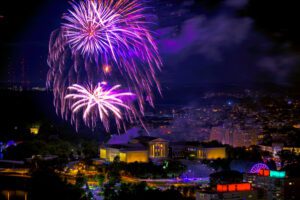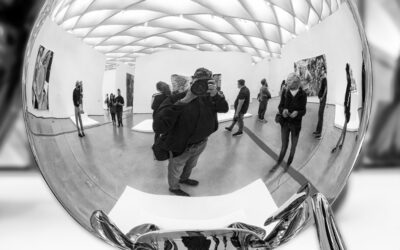I have 17 tips for you to shoot stunning Fourth of July fireworks photos on Independence Day evening in the U.S.
 On Friday, the U.S. will celebrate Independence Day, commemorating the ratification of the Declaration of Independence by the Second Continental Congress on July 4, 1776, in Philadelphia, Pennsylvania. It was adopted and signed in the Pennsylvania State House, now called Independence Hall. The country celebrates with lots of fireworks photos.
On Friday, the U.S. will celebrate Independence Day, commemorating the ratification of the Declaration of Independence by the Second Continental Congress on July 4, 1776, in Philadelphia, Pennsylvania. It was adopted and signed in the Pennsylvania State House, now called Independence Hall. The country celebrates with lots of fireworks photos.
John Adams, the second President of the US, explained how Independence Day should be celebrated.
Americans can thank John Adams, the second U.S. President, for how we celebrate Independence Day. In his July 3, 1776, letter to his wife Abigail, he said that the day should be “solemnized with pomp and parade, with shews, games, guns, bells, bonfires and illuminations from one end of this continent to the other from this time forward forever more.”
The Pennsylvania Evening Post described how the Fourth of July was celebrated on its first anniversary in Philadelphia. The celebration hasn’t changed much since then. Today, taking fireworks photos is an important part of the weekend.
The Pennsylvania Evening Post described the evening of July 4, 1777, in Philadelphia. “The evening closed with the ring of bells and at night there was a grand exhibition of fireworks (which began and concluded with thirteen rockets) on the Commons and the city was beautifully illuminated.”
In that tradition, on this July 4, at the steps of the Philadelphia Museum of Art, aka “Rocky steps,” following a concert by Jazmine Sullivan and LL Cool J, in front of a half million Philadelphians and visitors. one of the nation’s best and largest fireworks shows will occur. I’ve secured a great perch to see and photograph the fireworks from a high-rise roof top.
To successfully photograph fireworks you have to understand that they are extremely bright and persist for several seconds before fading. Against an almost black background of the night sky, the contrast between the fireworks and sky exceeds the dynamic range of typical digital camera sensors. Focus and exposure settings for fireworks photography must be thought out.
Here are my 17 top tips for you to capture your memories of this year’s Independence Day celebration in your community.
If you’re traveling in the U.S. this week and want to get great images of the fireworks near you, here are my fireworks’ photography tips for both digital cameras and smartphones.
Scout for a location and choose wisely:
Fireworks draw large crowds. Find a position where people won’t wander in front of you and accidentally knock into your equipment. Choose an upwind location from the fireworks to avoid their smoke, which can obscure your images. Avoid unwanted light from street lamps. Consider the setting’s background. Look out for tree branches that could intrude into your photo.
Arrive early:
To be able to claim the great spot you scouted, arrive early. Make a few test photos to ensure nothing unexpected shows up in your images, like a light or branch.
Start with a fully charged battery:
You don’t want to run out of power before the end of the show.
Have enough free memory:
I typically take photos of every fireworks’ burst. I format the largest memory card I have, so it’s at full capacity in my camera. For smartphones, consider off-loading as many photo and video files as possible, so you have plenty of room for shooting the fireworks.
Use the best photo quality settings for the best photos of the fireworks, use daylight white balance, turn off your flash and frame your fireworks scene well.

I shoot fireworks exclusively in RAW format. Some smartphones have a RAW capability too. If they do, use it. If you take your photos in HEIF or JPG, chose the best quality and the largest size (least compression) to avoid compression artifacts which often occur in scenes with high luminance and color contrast, as found in fireworks’ images.
White Balance:
Set your white balance to daylight.
Frame your photo well:
A vertical format is generally better as the trail of a skyrocket is usually upward and not wide. Frame your image so you have a reasonably sized foreground and “head-room” above the topmost fireworks’ bursts. For cameras, your position relative to the fireworks display will determine your optimal lens focal length.
Turn off your flash:
Your flash is useless for photographing fireworks themselves. It will only wash out the colors of your photos. If you’re trying to light something in the foreground to give your photo context and extra interest, then turn on the flash for that only and be careful that the flash isn’t pointed up.
Add a foreground subject:
Possibly add a statue, crowd silhouettes, a tree or building in the foreground for context and interest.
Steady your camera or smartphone to hold them still with a tripod or another device, use manual focus and a remote shutter release, even on a smartphone, for the sharpest fireworks’ images.
Always use a tripod:
Whether you’re shooting with a camera or smartphone, fireworks’ photography requires long exposures to capture both light trails and full bursts in your photos. That requires camera support to ensure sharp images. Use a tripod appropriate for your equipment.
Use manual focus:
The fireworks will likely be several hundred yards/meters away or more. It’s difficult to focus in darkness, so focus manually and set it to infinity. For cameras or smartphones that don’t have manual focus, use landscape mode to approximate it.
Use a remote shutter release:
Minute movements of your camera or smartphone can blur your images. When using either, use a remote shutter release, if possible, to avoid shake caused by pressing the shutter release button. Most cameras accept wireless or wired remote shutter releases. For iPhones, if you have an Apple Watch, you can use it as a remote shutter release with several apps such as Halide Mark II, which I recommend below.
Set your exposure parameters thoughtfully for ISO, aperture and shutter use to get images of the trail and burst of the fireworks.
Choose a low ISO setting for your photos:
To minimize digital noise in your fireworks’ photos use a low ISO setting of 50–200.
Base your aperture on your ISO setting:
A good starting point would be ISO 100 – f/8 to f/16 or ISO 200 – f/11 to f/22 on your camera. On smartphones you’ll need to experiment to find the best exposure value (EV). Check your photos as you shoot and adjust the aperture or EV as necessary.
It’s night, but you don’t need extremely long exposures:
Fireworks are very bright lights. Set your camera to manual exposure mode. I expose my fireworks’ photos from 1 to 4 seconds to capture the trail(s) and burst(s). If your camera or smartphone app has a B (Bulb) shutter setting, you can use it for long exposures. Try to anticipate the beginning of the burst and open the shutter. Close it immediately after it reaches its peak.
Disable your Smartphone’s HDR:
High Dynamic Range (HDR) can sometimes hinder the capture of the colors of the fireworks.
For the best fireworks photos using your smartphone, get a better camera app than the one that comes with your smartphone.
For smartphones, get a camera app that allows manual shooting:
Fireworks’ images are best made when you can set your smartphone camera’s exposure settings manually. Most camera apps that come standard on smartphones have limited manual capability or don’t have it at all. For Android, consider Camera FV-5 ($4.99). For the iPhone, I use Halide Mark II ($19.99 annual subscription). Both of these apps provide extensive manual control to make great fireworks’ photos.
Have a blast shooting fireworks on July 4th.

(Image: Philadelphia Welcomes America, Independence Day celebration, on the Parkway at the Philadelphia Museum of Art Copyright © 2023 NSL Photography. All Rights Reserved. All TDM and AI Training are Prohibited.)
READ ALSO:
Take Action — Keep Public Lands in Public Hands — Contact Congress
Trip insurance is an important part of your travel planning
After many years working in corporate America as a chemical engineer, executive and eventually CFO of a multinational manufacturer, Ned founded a tech consulting company and later restarted NSL Photography, his photography business. Before entering the corporate world, Ned worked as a Public Health Engineer for the Philadelphia Department of Public Health. As a well known corporate, travel and wildlife photographer, Ned travels the world writing about travel and photography, as well as running photography workshops, seminars and photowalks. Visit Ned’s Photography Blog and Galleries.



